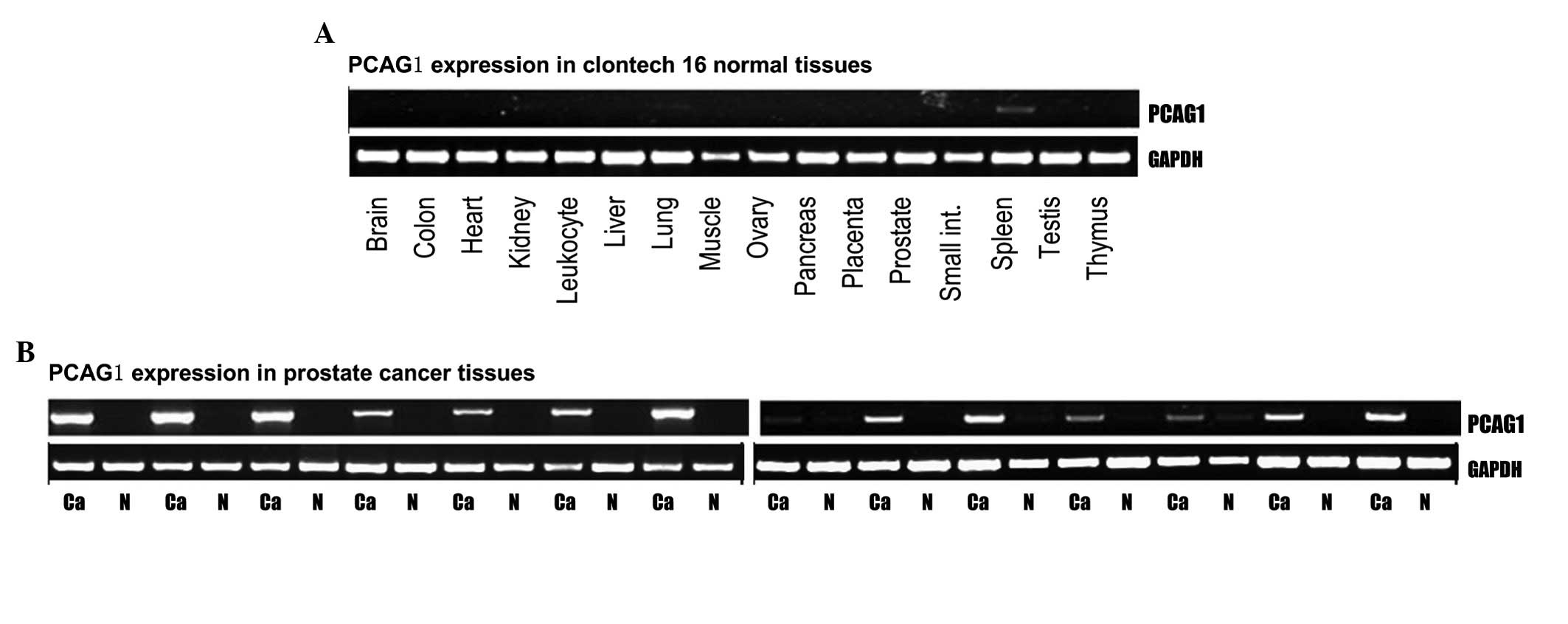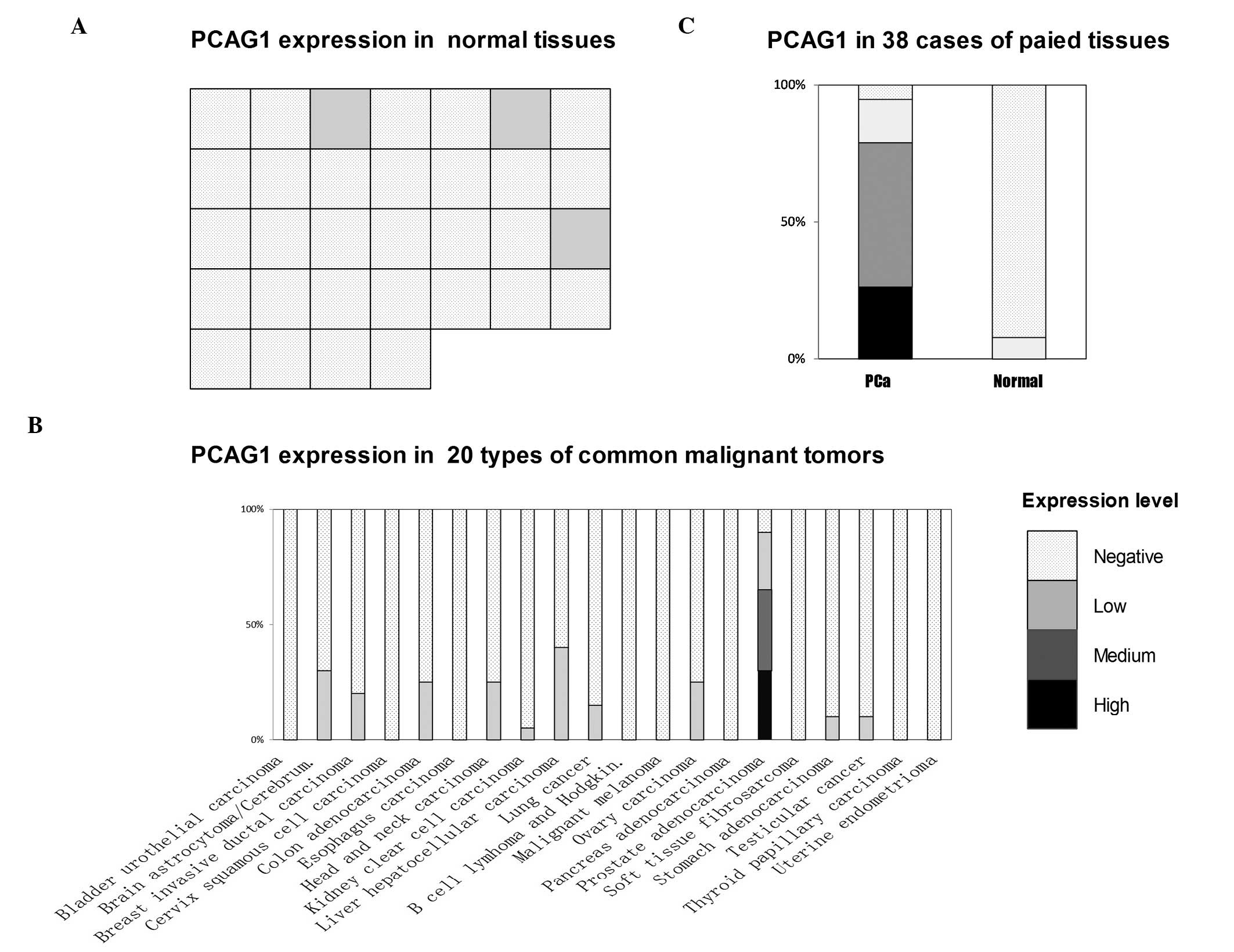Identification of PCAG1 as a novel prostate cancer-associated gene
- Authors:
- Yongqing Lai
- Zuhu Yu
- Yadong Wang
- Jiongxian Ye
View Affiliations
Affiliations: Department of Urology, Peking University Shenzhen Hospital, Shenzhen, P.R. China, Guangdong and Shenzhen Key Laboratory of Male Reproductive Medicine and Genetics, Institute of Urology, Peking University Shenzhen Hospital, Shenzhen PKU‑HKUST Medical Center, Shenzhen, P.R. China
- Published online on: December 24, 2012 https://doi.org/10.3892/mmr.2012.1249
-
Pages:
755-760
Metrics: Total
Views: 0 (Spandidos Publications: | PMC Statistics: )
Metrics: Total PDF Downloads: 0 (Spandidos Publications: | PMC Statistics: )
This article is mentioned in:
Abstract
The aim of the present study was to identify a new prostate cancer‑associated gene and analyze its expression pattern. Comprehensive expression analysis of expressed sequence tags (ESTs) and microarray data and serial analysis of gene expression (SAGE) were conducted to screen in silico for candidate prostate cancer‑associated genes. Reverse transcription (RT)-PCR was performed to validate prostate cancer specificity. Prostate cancer‑associated gene 1 (PCAG1) was identified. The expression of PCAG1 mRNA and protein was evaluated in common human normal tissues, common malignant tumors, prostate adenocarcinoma and paired adjacent normal prostate tissues. An immunofluorescence assay was conducted to determine the subcellular location of PCAG1. PCAG1 mRNA was absent in the 15 pooled normal tissues (including normal prostate tissue) but registered at low levels in the spleen tissue (+). By contrast, PCAG1 mRNA was significantly higher than in the adjacent normal tissues in each of the 14 cases of prostate cancer, with ~50% scoring a high degree of expression (+++). Of the 32 types of normal tissues, 29 (including normal prostate tissue) demonstrated negative PCAG1 protein staining while the remaining tissues of the adrenal gland, parathyroid gland and liver expressed low levels. While 18/20 cases of prostate adenocarcinoma showed positive expression results, PCAG1 protein expression in the remaining types of cancer was scarce when present at all; only 41/380 other cancer cases demonstrated positive results at a low level. The most substantial PCAG1-positive expression results were identified by cytoplasmic staining in 36/38 prostate adenocarcinoma cases, with 10 cases showing high expression levels, 20 showing medium levels and 6 showing low levels. In the paired adjacent normal prostate tissues, only 3/38 cases showed low level positive staining, while 35/38 cases were negative. Immunofluorescent staining of the human prostate cancer PC3 cell line showed positive PCAG1 expression results in the mitochondria. The present study demonstrated that while PCAG1 mRNA was highly expressed in prostate cancer tissues, it was almost absent in all common normal tissues and paired adjacent normal prostate tissues. Furthermore, PCAG1 protein was also highly expressed in prostate cancer tissues, while few common normal tissues, other common malignant tumors and paired adjacent normal prostate tissues had even low levels of expression. Clarification of the function and transcriptional mechanism of PCAG1 may aid the elucidation of the mechanisms of carcinogenesis and progression of prostate cancer. The unique expression pattern of PCAG1 suggests its potential in certain clinical applications.
View References
|
1
|
Bray F, Lortet-Tieulent J, Ferlay J,
Forman D and Auvinen A: Prostate cancer incidence and mortality
trends in 37 European countries: an overview. Eur J Cancer.
46:3040–3052. 2010. View Article : Google Scholar : PubMed/NCBI
|
|
2
|
Siegel R, Ward E, Brawley O and Jemal A:
Cancer statistics, 2011: the impact of eliminating socioeconomic
and racial disparities on premature cancer deaths. CA Cancer J
Clin. 61:212–236. 2011. View Article : Google Scholar : PubMed/NCBI
|
|
3
|
Shen MM and Abate-Shen C: Molecular
genetics of prostate cancer: new prospects for old challenges.
Genes Dev. 24:1967–2000. 2010. View Article : Google Scholar : PubMed/NCBI
|
|
4
|
Sardana G, Dowell B and Diamandis EP:
Emerging biomarkers for the diagnosis and prognosis of prostate
cancer. Clin Chem. 54:1951–1960. 2008. View Article : Google Scholar : PubMed/NCBI
|
|
5
|
Shariat SF, Scherr DS, Gupta A, et al:
Emerging biomarkers for prostate cancer diagnosis, staging, and
prognosis. Arch Esp Urol. 64:681–694. 2011.(In English and
Spanish).
|
|
6
|
Krizman DB, Wagner L, Lash A, Strausberg
RL and Emmert-Buck MR: The Cancer Genome Anatomy Project: EST
sequencing and the genetics of cancer progression. Neoplasia.
1:101–106. 1999. View Article : Google Scholar : PubMed/NCBI
|
|
7
|
Bao S, Ouyang G, Bai X, et al: Periostin
potently promotes metastatic growth of colon cancer by augmenting
cell survival via the Akt/PKB pathway. Cancer Cell. 5:329–339.
2004. View Article : Google Scholar : PubMed/NCBI
|
|
8
|
Chow WH, Dong LM and Devesa SS:
Epidemiology and risk factors for kidney cancer. Nat Rev Urol.
7:245–257. 2010. View Article : Google Scholar : PubMed/NCBI
|
|
9
|
Tsuchiya A, Sakamoto M, Yasuda J, et al:
Expression profiling in ovarian clear cell carcinoma:
identification of hepatocyte nuclear factor-1 beta as a molecular
marker and a possible molecular target for therapy of ovarian clear
cell carcinoma. Am J Pathol. 163:2503–2512. 2003. View Article : Google Scholar
|
|
10
|
Gerhard DS, Wagner L, Feingold EA, et al;
MGC Project Team. The status, quality, and expansion of the NIH
full-length cDNA project: the Mammalian Gene Collection (MGC).
Genome Res. 14:2121–2127. 2004. View Article : Google Scholar : PubMed/NCBI
|
|
11
|
Lamesch P, Li N, Milstein S, et al:
hORFeome v3.1: a resource of human open reading frames representing
over 10,000 human genes. Genomics. 89:307–315. 2007.PubMed/NCBI
|
|
12
|
Strausberg RL, Feingold EA, Grouse LH, et
al; Mammalian Gene Collection Program Team. Generation and initial
analysis of more than 15,000 full-length human and mouse cDNA
sequences. Proc Natl Acad Sci USA. 99:16899–16903. 2002. View Article : Google Scholar : PubMed/NCBI
|
|
13
|
UniProt Consortium. Reorganizing the
protein space at the Universal Protein Resource (UniProt). Nucleic
Acids Res. 40:D71–D75. 2012.PubMed/NCBI
|
|
14
|
Lane L, Argoud-Puy G, Britan A, et al:
neXtProt: a knowledge platform for human proteins. Nucleic Acids
Res. 40:D76–D83. 2012. View Article : Google Scholar : PubMed/NCBI
|












